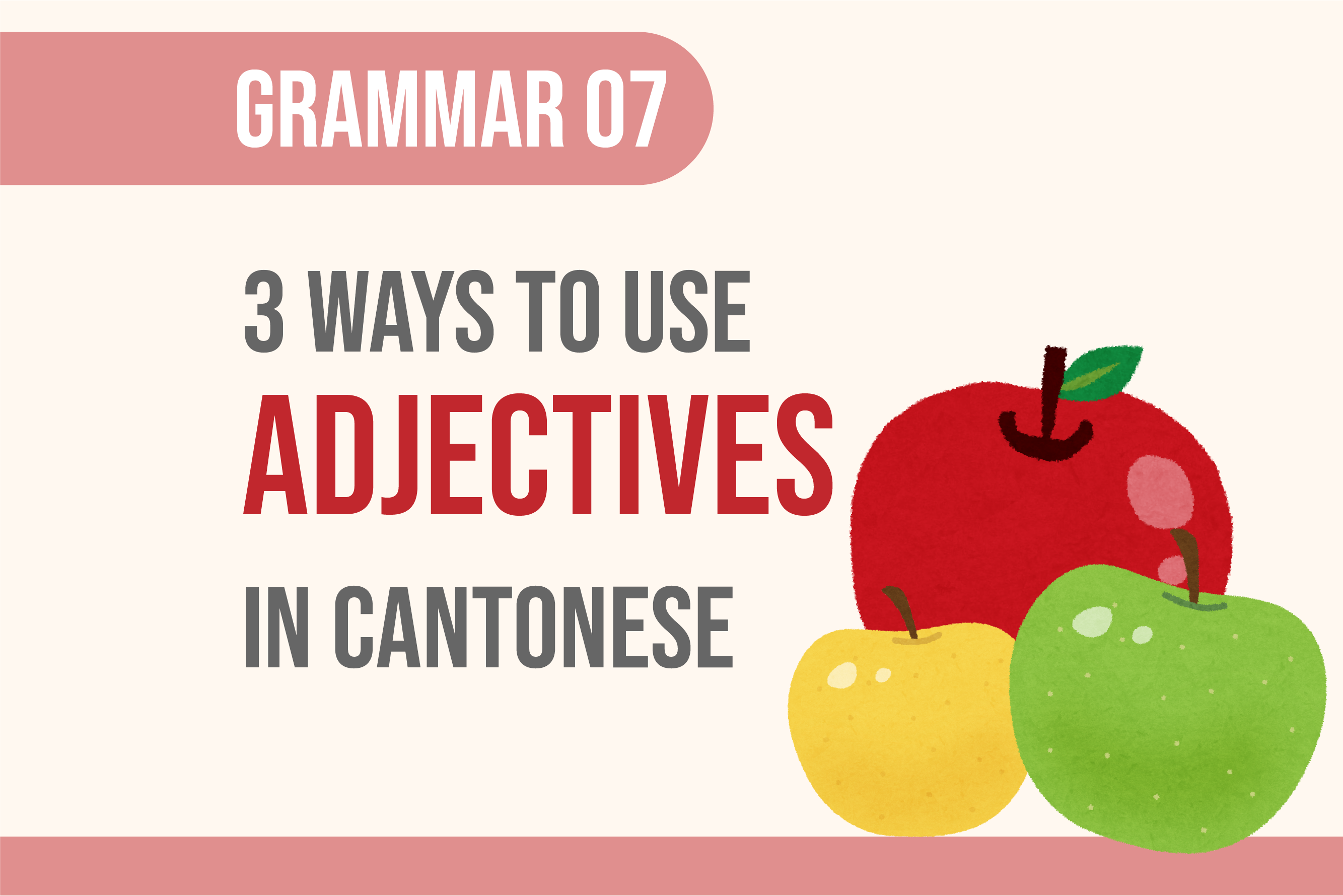Table of Content
In Cantonese, there are three ways to describe an object with an adjective:
1. Using adverbs of degree such as 好(very)/有啲 (a bit) /幾 to make a statement sentence. In Mandarin, the equivalents are 很/不是很/蠻、挺/有點.
2. Using adverbs of degree and 嘅 to connect the noun and the adjective, forming a new noun phrase.
3. Directly using a noun after an adjective to form a new noun (not every combination of adjective and noun can be used this way)
Pattern 1 - Adverbs of degree + Adjective + Noun
This pattern is equivalent to how English uses "sth. IS (adj.)" to describe an object.
(+ve)
【noun - adv. of degree - adj.】
(-ve)
【noun - 唔 - adj.】 or
【noun - 唔 係 - adv. of degree - adj.】
佢啲頭髮有啲長
His/Her hair is a bit long.佢個女好聰明
His/Her daughter is (very) clever.呢杯咖啡唔熱
This (cup of) coffee is not hot.OR
呢杯咖啡唔係好熱
This (cup of) coffee is not very hot.
(#Notice how 係(to be) is used in negative sentence but not in positive sentence.)
Adverbs of degree are optional in English, but in Cantonese, we almost always use them before adjectives. When giving a neutral description, we often place 好 before the adjective. You might wonder if this makes it sound like you're saying "very + adjective," but it usually doesn't carry that intense meaning. If you want to emphasize "very," you'd use other degree adverbs like 超 (super), 勁 (strongly), 極 (extremely), 激 (drastically), 爆 (explosively).
So even if you want to make a neutral statement or description like "today is hot," it would be unnatural to just say 今日熱 (lit. Today hot) or 今日係熱 (lit. Today is hot). The most natural way is 今日好熱 (lit. Today very hot).
# We usually do not use 係 (to be) when the noun is followed by an adjective in positive sentence. For example, 呢張枱係大 (lit. This table is big) or 呢張枱係好大 (lit. This table is very big) is rarely used when making a neutral statement. Although this sentence has its own meaning, it is an advanced usage, which is usually followed by a “but…” clause.
However, for negative sentence, you need to use 唔係 (not to be) before the "adverb of degree + adjective" combo.
Additional Notes
Sometimes we do not use an adjective to describe an object directly in Cantonese. Instead, we turn the adjective into a noun phrase, then use linking verb 係 (verb to be) to connect that the noun and the noun phrase.
For example, for "This apple is red", we do not say 呢個蘋果好紅 (which would emphasize that the apple is really red), instead we say 呢個蘋果係紅色嘅 (lit. This apple is red in color)
Pattern 2 - Adverbs of degree + Adjective + 嘅 + Noun
This pattern expands the original noun to form a new noun phrase, which functions as a noun itself. It's similar to how we describe things in English, like "big tables", "difficult books", or "tall trees".
【adv. of degree - adj. - 嘅 - noun】
(嗰張枱係我嘅)
(That table is mine)
嗰張好大嘅枱係我嘅
That (very) big table is mine.(我有一本書)
(I have a book)
我有一本好難嘅書
I have a (very) difficult book.(嗰度有棵樹)
(There is a tree)
嗰度有棵好高嘅樹
There is a (very) tall tree.
Pattern 3 - Adjective + Noun
This pattern forms a new noun, which is usually a combination used as a habitual expression. It's also similar to how we describe things in English, like "red apples", "cold water", or "small cups."
【adj. - noun】
(我鍾意食蘋果)
(I like to eat apples.)我鍾意食紅蘋果
I like to eat red apples.(嗰隻杯係你嘅)
(That cup is yours.)嗰隻細杯係你嘅
That small cup is yours.(我個仔喺屋企)
(My son is at home.)我個大仔喺屋企
My eldest son is at home.(我唔飲水)
(I do not drink water.)我唔飲凍水
I do not drink cold water.
Note that not every combination of adjective and noun can form an independent noun (Pattern 3).
For example, 好難嘅書 (difficult book) and 好高嘅樹 (tall tree) in Pattern 2 are rarely said as 難書 and 高樹 as independent nouns. Whether or not a noun can be directly modified by an adjective without the use of 嘅 depends on convention.
In this lesson, we combine the usage of adjectives with the linking verb 係, possessive determiners, and demonstratives in the example sentences. Review those concepts from the previous lessons if necessary.
